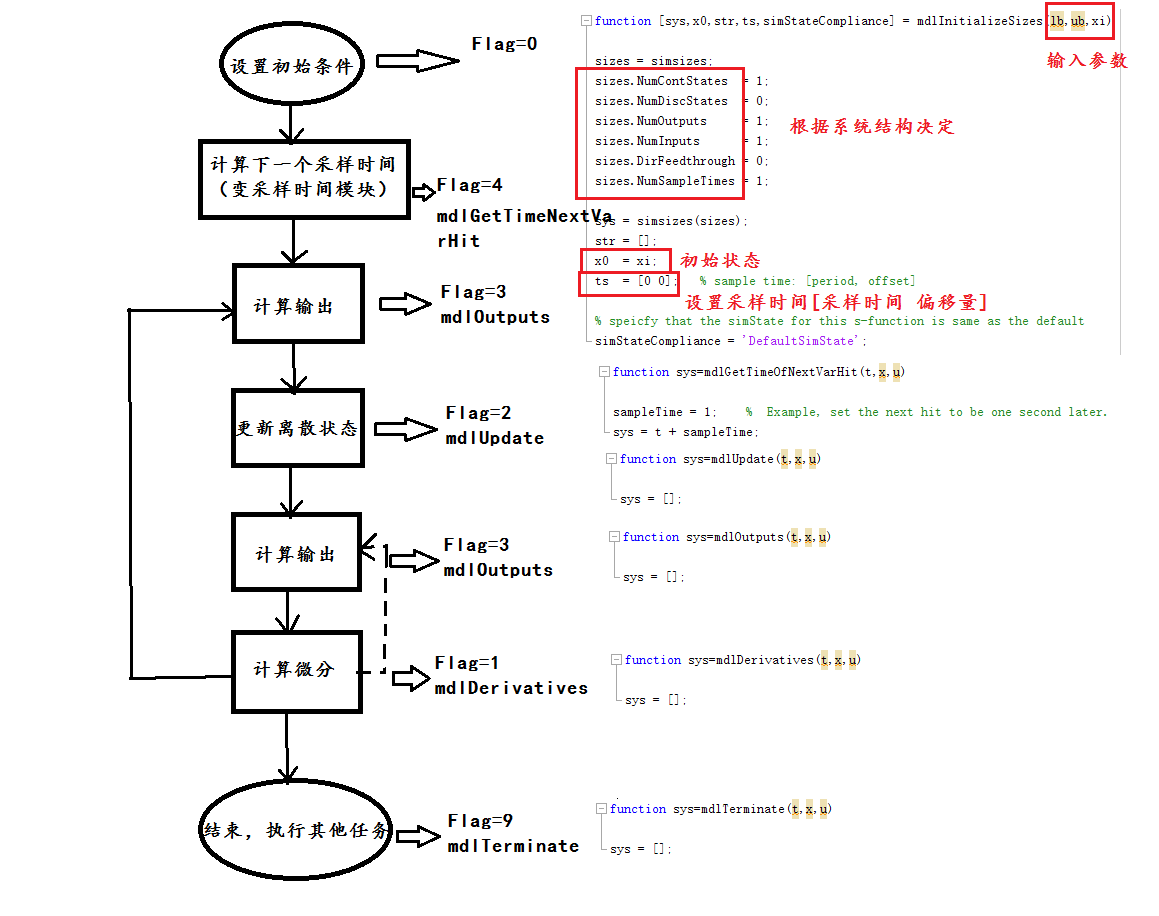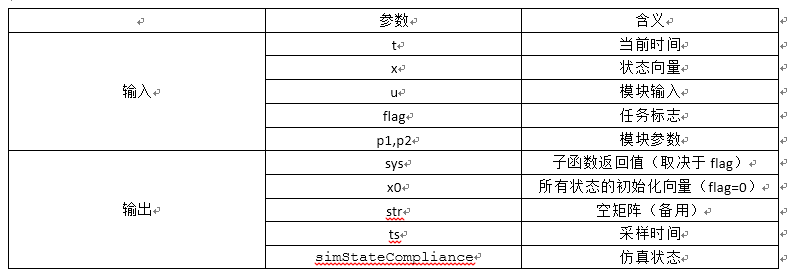Matlab 中S-函数的使用 sfuntmpl
function [sys,x0,str,ts,simStateCompliance] = sfuntmpl(t,x,u,flag)
%SFUNTMPL General MATLAB S-Function Template
% With MATLAB S-functions, you can define you own ordinary differential
% equations (ODEs), discrete system equations, and/or just about
% any type of algorithm to be used within a Simulink block diagram.
%
% The general form of an MATLAB S-function syntax is:
% [SYS,X0,STR,TS,SIMSTATECOMPLIANCE] = SFUNC(T,X,U,FLAG,P1,...,Pn)
%
% What is returned by SFUNC at a given point in time, T, depends on the
% value of the FLAG, the current state vector, X, and the current
% input vector, U.
%
% FLAG RESULT DESCRIPTION
% ----- ------ --------------------------------------------
% 0 [SIZES,X0,STR,TS] Initialization, return system sizes in SYS,
% initial state in X0, state ordering strings
% in STR, and sample times in TS.
% 1 DX Return continuous state derivatives in SYS.
% 2 DS Update discrete states SYS = X(n+1)
% 3 Y Return outputs in SYS.
% 4 TNEXT Return next time hit for variable step sample
% time in SYS.
% 5 Reserved for future (root finding).
% 9 [] Termination, perform any cleanup SYS=[].
%
%
% The state vectors, X and X0 consists of continuous states followed
% by discrete states.
%
% Optional parameters, P1,...,Pn can be provided to the S-function and
% used during any FLAG operation.
%
% When SFUNC is called with FLAG = 0, the following information
% should be returned:
%
% SYS(1) = Number of continuous states.
% SYS(2) = Number of discrete states.
% SYS(3) = Number of outputs.
% SYS(4) = Number of inputs.
% Any of the first four elements in SYS can be specified
% as -1 indicating that they are dynamically sized. The
% actual length for all other flags will be equal to the
% length of the input, U.
% SYS(5) = Reserved for root finding. Must be zero.
% SYS(6) = Direct feedthrough flag (1=yes, 0=no). The s-function
% has direct feedthrough if U is used during the FLAG=3
% call. Setting this to 0 is akin to making a promise that
% U will not be used during FLAG=3. If you break the promise
% then unpredictable results will occur.
% SYS(7) = Number of sample times. This is the number of rows in TS.
%
%
% X0 = Initial state conditions or [] if no states.
%
% STR = State ordering strings which is generally specified as [].
%
% TS = An m-by-2 matrix containing the sample time
% (period, offset) information. Where m = number of sample
% times. The ordering of the sample times must be:
%
% TS = [0 0, : Continuous sample time.
% 0 1, : Continuous, but fixed in minor step
% sample time.
% PERIOD OFFSET, : Discrete sample time where
% PERIOD > 0 & OFFSET < PERIOD.
% -2 0]; : Variable step discrete sample time
% where FLAG=4 is used to get time of
% next hit.
%
% There can be more than one sample time providing
% they are ordered such that they are monotonically
% increasing. Only the needed sample times should be
% specified in TS. When specifying more than one
% sample time, you must check for sample hits explicitly by
% seeing if
% abs(round((T-OFFSET)/PERIOD) - (T-OFFSET)/PERIOD)
% is within a specified tolerance, generally 1e-8. This
% tolerance is dependent upon your model's sampling times
% and simulation time.
%
% You can also specify that the sample time of the S-function
% is inherited from the driving block. For functions which
% change during minor steps, this is done by
% specifying SYS(7) = 1 and TS = [-1 0]. For functions which
% are held during minor steps, this is done by specifying
% SYS(7) = 1 and TS = [-1 1].
%
% SIMSTATECOMPLIANCE = Specifices how to handle this block when saving and
% restoring the complete simulation state of the
% model. The allowed values are: 'DefaultSimState',
% 'HasNoSimState' or 'DisallowSimState'. If this value
% is not speficified, then the block's compliance with
% simState feature is set to 'UknownSimState'.
% Copyright 1990-2010 The MathWorks, Inc.
%
% The following outlines the general structure of an S-function.
%
switch flag,
%%%%%%%%%%%%%%%%%%
% Initialization %
%%%%%%%%%%%%%%%%%%
case 0,
[sys,x0,str,ts,simStateCompliance]=mdlInitializeSizes;
%%%%%%%%%%%%%%%
% Derivatives %
%%%%%%%%%%%%%%%
case 1,
sys=mdlDerivatives(t,x,u);
%%%%%%%%%%
% Update %
%%%%%%%%%%
case 2,
sys=mdlUpdate(t,x,u);
%%%%%%%%%%%
% Outputs %
%%%%%%%%%%%
case 3,
sys=mdlOutputs(t,x,u);
%%%%%%%%%%%%%%%%%%%%%%%
% GetTimeOfNextVarHit %
%%%%%%%%%%%%%%%%%%%%%%%
case 4,
sys=mdlGetTimeOfNextVarHit(t,x,u);
%%%%%%%%%%%%%
% Terminate %
%%%%%%%%%%%%%
case 9,
sys=mdlTerminate(t,x,u);
%%%%%%%%%%%%%%%%%%%%
% Unexpected flags %
%%%%%%%%%%%%%%%%%%%%
otherwise
DAStudio.error('Simulink:blocks:unhandledFlag', num2str(flag));
end
% end sfuntmpl
%
%=============================================================================
% mdlInitializeSizes
% Return the sizes, initial conditions, and sample times for the S-function.
%=============================================================================
%
function [sys,x0,str,ts,simStateCompliance]=mdlInitializeSizes
%
% call simsizes for a sizes structure, fill it in and convert it to a
% sizes array.
%
% Note that in this example, the values are hard coded. This is not a
% recommended practice as the characteristics of the block are typically
% defined by the S-function parameters.
%
sizes = simsizes;
sizes.NumContStates = 0;
sizes.NumDiscStates = 0;
sizes.NumOutputs = 0;
sizes.NumInputs = 0;
sizes.DirFeedthrough = 1;
sizes.NumSampleTimes = 1; % at least one sample time is needed
sys = simsizes(sizes);
%
% initialize the initial conditions
%
x0 = [];
%
% str is always an empty matrix
%
str = [];
%
% initialize the array of sample times
%
ts = [0 0];
% Specify the block simStateCompliance. The allowed values are:
% 'UnknownSimState', < The default setting; warn and assume DefaultSimState
% 'DefaultSimState', < Same sim state as a built-in block
% 'HasNoSimState', < No sim state
% 'DisallowSimState' < Error out when saving or restoring the model sim state
simStateCompliance = 'UnknownSimState';
% end mdlInitializeSizes
%
%=============================================================================
% mdlDerivatives
% Return the derivatives for the continuous states.
%=============================================================================
%
function sys=mdlDerivatives(t,x,u)
sys = [];
% end mdlDerivatives
%
%=============================================================================
% mdlUpdate
% Handle discrete state updates, sample time hits, and major time step
% requirements.
%=============================================================================
%
function sys=mdlUpdate(t,x,u)
sys = [];
% end mdlUpdate
%
%=============================================================================
% mdlOutputs
% Return the block outputs.
%=============================================================================
%
function sys=mdlOutputs(t,x,u)
sys = [];
% end mdlOutputs
%
%=============================================================================
% mdlGetTimeOfNextVarHit
% Return the time of the next hit for this block. Note that the result is
% absolute time. Note that this function is only used when you specify a
% variable discrete-time sample time [-2 0] in the sample time array in
% mdlInitializeSizes.
%=============================================================================
%
function sys=mdlGetTimeOfNextVarHit(t,x,u)
sampleTime = 1; % Example, set the next hit to be one second later.
sys = t + sampleTime;
% end mdlGetTimeOfNextVarHit
%
%=============================================================================
% mdlTerminate
% Perform any end of simulation tasks.
%=============================================================================
%
function sys=mdlTerminate(t,x,u)
sys = [];
% end mdlTerminate
S-函数的几个概念:
1) 直接馈通
在编写S-函数时,初始化函数中需要对sizes.DirFeedthrough 进行设置,如果输出函数mdlOutputs或者对于变采样时间的mdlGetTimeOfNextVarHit是输入u的函数,则模块具有直接馈通的特性sizes.DirFeedthrough=1;否则为0。
2) 采样时间
仿真步长就是整个模型的基础采样时间,各个子系统或模块的采样时间,必须以这个步长为整数倍。
连续信号和离散信号对计算机而言其实都是采样而来的,只是采样时间不同,连续信号采样时间可认为趋于0且基于微分方程,离散信号采样时间比较长基于差分方程。离散信号当前状态由前一个时刻的状态决定,连续信号可以通过微分方程计算得到。如果要将连续信号离散化还要考虑下信号能否恢复的问题,即香农定理。
采样时间点的确定:下一个采样时间=(n*采样间隔)+ 偏移量,n表示当前的仿真步,从0开始。
对于连续采样时间,ts可以设置为[0 0],其中偏移量为0;
对于离散采样时间,ts假设为[0.25 0.1],表示在S-函数仿真开始后0.1s开始每隔0.25s运行一次,当然每个采样时刻都会调用mdlOutPuts和mdlUpdate函数;
对于变采样时间,即离散采样时间的两次采样时间间隔是可变的,每次仿真步开始时都需要用mdlGetTimeNextVarHit计算下一个采样时间的时刻值。ts可以设置为[-2 0]。
对于多个任务,每个任务都可以以不同的采样速率执行S-函数,假设任务A在仿真开始每隔0.25s执行一次,任务B在仿真后0.1s每隔1s执行一次,那么ts设置为[0.25 0.1;1.0 0.1],具体到S-函数的执行时间为[0 0.1 0.25 0.5 0.75 1.0 1.1…]。
如果用户想继承被连接模块的采样时间,ts只要设置为[-1 0]。


子函数的作用

(1).mdlInitializeSizes函数-初始化函数
function[sys,x0,str,ts,simStateCompliance]=mdlInitializeSizes
sizes = simsizes;
sizes.NumContStates = 0; %连续状态个数
sizes.NumDiscStates = 0; %离散状态个数
sizes.NumOutputs = 0; %输出个数
sizes.NumInputs = 0; %输入个数
sizes.DirFeedthrough = 1; %是否直接馈通
sizes.NumSampleTimes = 1; %采样时间个数,至少一个
sys = simsizes(sizes); %将size结构传到sys中
x0 = []; %初始状态向量,由传入的参数决定,没有为空
str = [];
ts = [0 0]; %设置采样时间,这里是连续采样,偏移量为0
% Specify the blocksimStateCompliance. The allowed values are:
% 'UnknownSimState', < The defaultsetting; warn and assume DefaultSimState
% 'DefaultSimState', < Same sim state as abuilt-in block
% 'HasNoSimState', < No sim state
% 'DisallowSimState' < Error out whensaving or restoring the model sim state
simStateCompliance = 'UnknownSimState';
(2).mdlGetTimeOfNextVarHit(t,x,u)函数-计算下一个采样时间
functionsys=mdlGetTimeOfNextVarHit(t,x,u)
sampleTime = 1; % Example, set the next hit to be one secondlater.
sys = t + sampleTime;
(3).mdlOutputs函数-计算S函数输出
functionsys=mdlOutputs(t,x,u)
sys = [];
(4).mdlUpdate函数-更新
function sys=mdlUpdate(t,x,u)
sys = [];
(5).mdlDerivatives函数-微分函数(计算连续状态导数)
functionsys=mdlDerivatives(t,x,u)
sys = [];
(6).mdlTerminate函数-终止仿真
functionsys=mdlTerminate(t,x,u)
sys = [];
function [sys,x0,str,ts,simStateCompliance] = sfuntmpl_c(t,x,u,flag)
%%%%Simulink中s函数模板的翻译版
%[sys,x0,str,ts,simStateCompliance] = sfuntmpl(t,x,u,flag,p1,…pn)
% flag result 描述
% —– —— ——————————————–
% 0 [sizes,x0,str,Ts] 初始化,返回SYS的大小,初始状态x0,str,采样时间Ts
% 1 DX 返回连续状态微分SYS.
% 2 DS 更新离散状态 SYS = X(n+1)
% 3 Y 返回输出SYS.
% 4 TNEXT Return next time hit for variable step sample time in SYS.
% 5 Reserved for future (root finding).
% 9 [] 结束 perform any cleanup SYS=[].
% 当flag=0时,以下信息必须赋值回传
% SYS(1) = 连续状态个数
% SYS(2) = 离散状态个数
% SYS(3) = 输出量个数
% SYS(4) = 输入量个数 注:上述4个变量可以赋值为-1,表示其值可变
% SYS(5) = 保留值。为0.
% SYS(6) = 直接馈通标志(1=yes, 0=no).如果u在flag=3时被使用,说明S函数是直接馈通,赋值为1. 否则为0.
% SYS(7) = 采样时间个数,Ts的行数
%
% X0 = 初始状态。没有则赋值为[].除flag=0外,被忽略。
% STR = 系统保留,设为[].
% TS = m*2 矩阵。(采样周期,偏移量)
% TS = [0 0, : 连续采样
% 0 1, : 在1个Ts后连续采样
% PERIOD OFFSET, : Discrete sample time where
% PERIOD > 0 & OFFSET < PERIOD.
% -2 0]; : 变步长离散采样,
% flag=4用于决定下一个采样时刻
% 注:
% 若希望每个时间步都运行,则设Ts=[0,0]
% 若希望继承采样时间运行,则设Ts=[-1,0]
% 若希望继承采样时间运行,且希望在微步内不变化,应该设Ts=[-1,1]
% 若希望仿真开始0.1s后每隔0.25秒运行,则设Ts=[0.25,0.1]
% 若希望按照不同速率执行不同任务,则Ts应按照升序排列。
% 即:每隔0.25秒执行一个任务,同时在开始0.1秒后,每隔1秒执行另一个任务
% Ts=[0.25,0; 1.0,0.1],则simulink将在下列时刻执行s函数[0,0.1,0.25,0.5,0.75,1,1.1,…]
% 以下是S函数的主函数
switch flag,
case 0, % 初始化
[sys,x0,str,ts,simStateCompliance]=mdlInitializeSizes;
case 1, % 连续时间导数
sys=mdlDerivatives(t,x,u);
case 2, % 更新离散状态量
sys=mdlUpdate(t,x,u);
case 3, % 计算输出
sys=mdlOutputs(t,x,u);
case 4, % 计算下一步采样时刻
sys=mdlGetTimeOfNextVarHit(t,x,u);
case 9, % 结束仿真
sys=mdlTerminate(t,x,u);
otherwise % 未知flag值
DAStudio.error('Simulink:blocks:unhandledFlag', num2str(flag));
end % S函数主程序结束
%=============================================================================
% mdlInitializeSizes
% 返回s函数的sizes、初始条件、采样时刻
%=============================================================================
function [sys,x0,str,ts,simStateCompliance]=mdlInitializeSizes
% 调用simsizes函数为sizes结构赋值
% simsizes函数是S函数模块特有的。它的结构和代码是固定的。
sizes = simsizes;
sizes.NumContStates = 0; %连续状态个数
sizes.NumDiscStates = 0; %离散状态个数
sizes.NumOutputs = 0; %输出量个数
sizes.NumInputs = 0; %输入量个数
sizes.DirFeedthrough = 1; %直接馈通标志
sizes.NumSampleTimes = 1; % 至少有一个采样时刻
sys = simsizes(sizes);
x0 = 0; % 状态初始化
str = []; % str 始终为空
ts = [0 0];% 初始化采样时间
% 指定simStateCompliance的值.
% ‘UnknownSimState’, < 默认值; warn and assume DefaultSimState
% ‘DefaultSimState’, < Same sim state as a built-in block
% ‘HasNoSimState’, < No sim state
% ‘DisallowSimState’ < Error out when saving or restoring the model sim state
simStateCompliance = 'UnknownSimState';
% 子函数mdlInitializeSizes 结束
%=============================================================================
% mdlDerivatives
% 返回连续状态量的导数
%=============================================================================
function sys=mdlDerivatives(t,x,u)
sys = [];
% 子函数mdlDerivatives结束
%=============================================================================
% mdlUpdate
%更新离散时间状态,采样时刻和主时间步的要求。
%=============================================================================
function sys=mdlUpdate(t,x,u)
sys = [];
% 子函数 mdlUpdate 结束
%=============================================================================
% mdlOutputs
% 计算并返回模块输出量
%=============================================================================
function sys=mdlOutputs(t,x,u)
sys = [];
% 子函数 mdlOutputs 结束
%=============================================================================
% mdlGetTimeOfNextVarHit
% 返回下一个采样时刻。注意返回结果是一个绝对时间,只在Ts=[-2,0]时使用。
%=============================================================================
function sys=mdlGetTimeOfNextVarHit(t,x,u)
sampleTime = 1; % 例子。设置下一个采样时刻为1s后。
sys = t + sampleTime;
% 子函数 mdlGetTimeOfNextVarHit 结束
%=============================================================================
% mdlTerminate
% 仿真结束
%=============================================================================
%
function sys=mdlTerminate(t,x,u)
sys = [];
% 子函数 mdlTerminate结束
function [sys,x0,str,ts,simStateCompliance]=limintm(t,x,u,flag,lb,ub,xi)
%传入的三个参数放在后面lb,ub,xi的位置
%LIMINTM Limited integrator implementation.
% Example MATLAB file S-function implementing a continuous limited integrator
% where the output is bounded by lower bound (LB) and upper bound (UB)
% with initial conditions (XI).
%
% See sfuntmpl.m for a general S-function template.
%
% See also SFUNTMPL.
% Copyright 1990-2009 The MathWorks, Inc.
% $Revision: 1.1.6.2 $
switch flag
%%%%%%%%%%%%%%%%%%
% Initialization %
%%%%%%%%%%%%%%%%%%
case 0
[sys,x0,str,ts,simStateCompliance] = mdlInitializeSizes(lb,ub,xi);
%%%%%%%%%%%%%%%
% Derivatives %
%%%%%%%%%%%%%%%
case 1
sys = mdlDerivatives(t,x,u,lb,ub);
%%%%%%%%%%%%%%%%%%%%%%%%
% Update and Terminate %
%%%%%%%%%%%%%%%%%%%%%%%%
case {2,9}
sys = []; % do nothing
%%%%%%%%%%
% Output %
%%%%%%%%%%
case 3
sys = mdlOutputs(t,x,u);
otherwise
DAStudio.error('Simulink:blocks:unhandledFlag', num2str(flag));
end
% end limintm
%
%=============================================================================
% mdlInitializeSizes
% Return the sizes, initial conditions, and sample times for the S-function.
%=============================================================================
%
function [sys,x0,str,ts,simStateCompliance] = mdlInitializeSizes(lb,ub,xi)
sizes = simsizes;
sizes.NumContStates = 1;%1个连续状态,即积分状态
sizes.NumDiscStates = 0;
sizes.NumOutputs = 1;
sizes.NumInputs = 1;
sizes.DirFeedthrough = 0;
sizes.NumSampleTimes = 1;
sys = simsizes(sizes);
str = [];
x0 = xi; %积分状态初始条件‘
ts = [0 0]; % sample time: [period, offset]
% speicfy that the simState for this s-function is same as the default
simStateCompliance = 'DefaultSimState';
% end mdlInitializeSizes
%
%=============================================================================
% mdlDerivatives
% Compute derivatives for continuous states.
%=============================================================================
%
function sys = mdlDerivatives(t,x,u,lb,ub)
if (x <= lb & u < 0) | (x>= ub & u>0 )
sys = 0;
else
sys = u;
end
% end mdlDerivatives
%
%=============================================================================
% mdlOutputs
% Return the output vector for the S-function
%=============================================================================
%
function sys = mdlOutputs(t,x,u)
sys = x;
% end mdlOutputs




